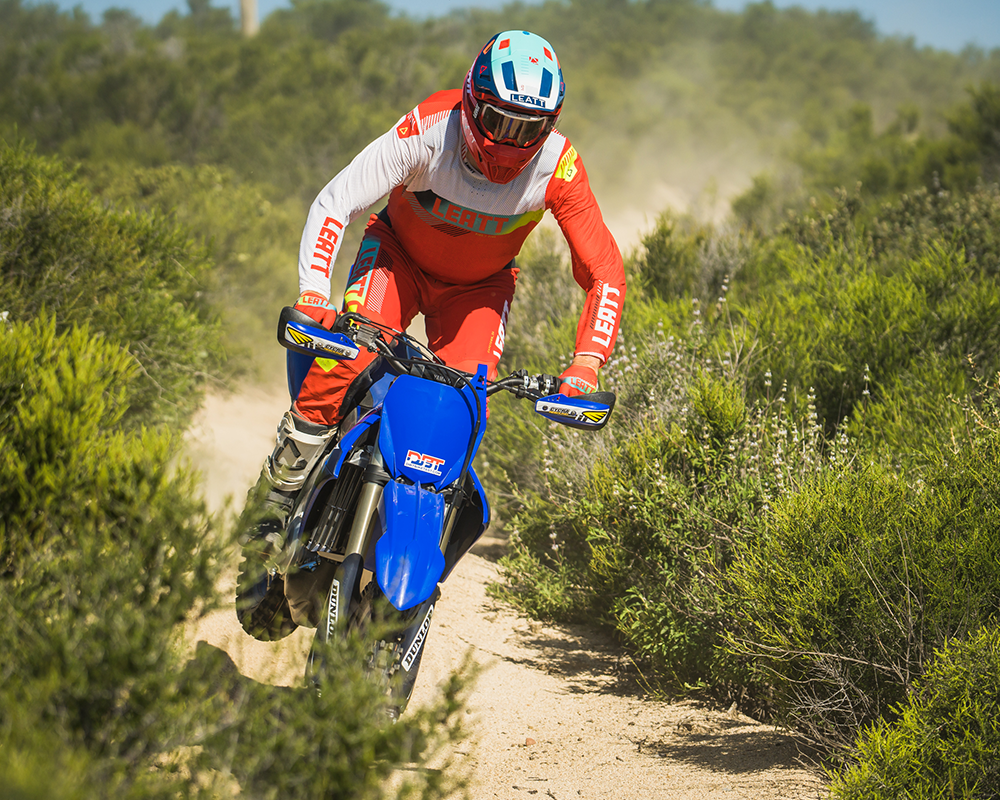With well over 100 hours of seat time on the current generation YZ450FX (2021-2023), we’ve found a few mods that are seemingly small on paper but make a world of difference in the dirt.

The YZ450FX comes stock with .46 kg/mm fork springs up front which are fairly light for such a big bike and the average weight of a 450cc rider. Stock forks feel pretty good, but increasing the spring rate anywhere from .48 – .50 transforms the bike. It keeps the front end riding higher in the stroke which in turn gives it a softer or “plusher” feel on the track and trails. The .46 springs had the front end riding in a stiffer part of the valving which gave it a harsh feeling, often confused for being too stiff by riders. But when putting stiffer springs in it, they brought the front end up to feel more supple and balanced the bike out greatly, helping upon corner entrance and avoiding unwanted bottoming. We tried all three fork spring rates (.48, .49, and .50) and all three worked well, it more so depending on what you were looking for. The .48’s felt plush and smooth, but still lacked some bottoming for hard charging riders. The .50’s are a little stiffer and less forgiving in small bump compliance, but handled bottoming well. The .49’s were in the middle and offered a good mix of both. Ultimately, we settled on .50 fork springs for faster terrains and faster riders aboard the bike, but any increase in spring rate is recommended for the majority of riders out there.
In addition to the fork springs, we opted for the same yet different shock spring. We stuck with the 5.7 kg/mm shock spring, but installed a “closed end” spring rather than the “open end” that comes stock. While this is more for a rider preference, it does change the handling quite a bit. With the closed end spring, we were again able to get a better balance out of the bike and keep the rear end flatter upon corner entrance. Again, this is more of a rider preference feel, but it is a change we made and liked after putting the stiffer fork springs in.

The cockpit on the Yamaha four-strokes are very mixed. Some riders love it while others hate it. The seat is dished out and makes the peg-seat ratio cramped, meanwhile the seat-handlebar ratio is lengthened out. To combat this, we did two things. First, a tall seat is welcomed by riders of nearly every size and shape. Even shorter riders in the 5’7 range applauded a taller seat. It helps with cornering, being easier to move forward on the bike, as well as brings you up higher to make the handlebars feel “lower”. Additionally, it’s easier to transition from sitting to standing, and vice versa, as there is less distance to move. In our case, we went with a Guts Racing Tall Seat that sits +25mm taller and boasts the optional “wings” that protrude on the sides. You can read the full Product Test HERE.


The next modification, this one being a free one, is mapping. Changing maps using the free GYTR Power Tuner App changes the engine character, which also can have an effect on the handling. Smoothing out the power delivery can have profound effects on smoothing out the handling feel, making the bike as a whole easier to ride. The stock map boasts robust power, with a slightly harder hit than we’d like. The two maps below are smoother down low but carry well into the top end. The Magic Map is the more aggressive of the two, and is preferable in faster conditions and when we ride taller gears. The JL Smooth Map is more suited to off-road and very smooth down low, but carrying tall gears isn’t quite as effective with this map. Depending on the rider, we’ll run either of these maps in Map 1 or Map 2 on the handlebar mounted switch (yes, there’s a difference with light on (Map 1) vs light off (Map 2).

Another big change we made, and this is geared more towards West Coast riders/racers than East Coasters, is a gearing change. Stock gearing is 13/50 and while the power is plentiful and the spacing is spot on, we went up on both ends in trying to find a tad more comfort out of the chassis. Going to larger sprockets on both ends changes the chain torque and has a big effect on both the chassis and power delivery (due to different gear ratios). In going up to 14/52, it helps settle the already smooth chassis and makes the bike feel as if it floats across the top of small acceleration chop, rather than through the bumps, and lightens the hit on bigger stuff. In addition, the smoothened out power feels electric and linear. It’s much easier to hold on to and it pulls each gear for so long without revving out or running out of power. Since it is taller than stock, we essentially ride the bike one gear lower than we used to. Rather than rolling corners in third gear, we now roll them in second gear. This gearing change gives you more top end for faster races/terrain, smoothes out the power, and gives you a more compliant chassis feel.

Some of these changes are easier and cheaper than others, but we felt all of these changed the feel of the Yamaha and for the better for our testers. The single best change we made is the stiffer fork springs as it helps the overall balance of the bike, but each mod has its place with the YZ450FX.
Do You Like DBT Bringing You Fresh Content? Search and Shop Through the Links Above or Below:


